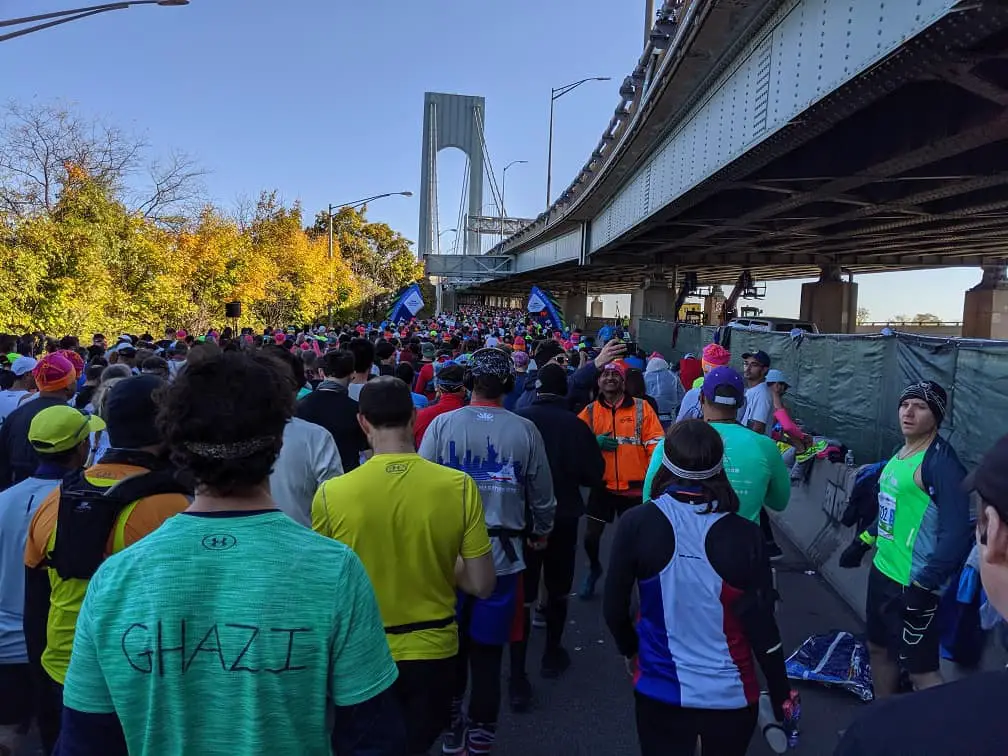The reason is simple: marathon runners wear foil blankets to keep themselves warm and prevent hypothermia.
Interestingly when I ran the Paris marathon in 2019, I (and everyone else) was given a foil blanket. However, when I ran it in 2023, no one was given a foil blanket.
I suspect environmental concerns have caused this trend. But why do (or did) marathon runners wear foil blankets at the end of the race?
After running for hours, their body temperature drops rapidly, and they risk becoming hypothermic.
Wrapping themselves in a reflective blanket helps maintain body temperature and avoid shivering.
At the same time, it may seem like a small thing, but wearing a foil blanket after a marathon can make a big difference in a runner’s recovery process.
Table of Contents
The Science Behind Foil Blankets
Foil blankets are ideal for long-distance runners as they help to prevent hypothermia.
They are included in emergency first aid because they come in small packages.
They are waterproof and windproof. In addition, foil blankets can provide help when weather conditions endanger people.
The blankets are thin, lightweight, and flexible material coated with a metallic finish.
The metallic finish reflects the body’s heat to the body, helping to maintain body temperature.
The material also helps trap and retain body heat, making it an ideal choice for marathon runners at risk of hypothermia after a race.
Runners generally do not wrap the blanket entirely and, instead, wear it like a superhero cape.
In addition, they do not wear the reflective side of the blanket inward, which reduces the warming effect.
The foil blanket helps runners maintain their body temperature and avoid shivering regardless of how worn.
Benefits of Wearing Foil Blankets for Marathon Runners
Marathon runners wear foil blankets for a variety of reasons. Here are some benefits of wearing foil blankets:
- Regulating Body Temperature: After a long race, the body temperature of marathon runners starts dropping off quickly. Wrapping a reflective blanket helps maintain body temperature and avoid shivering.
- Preventing Hypothermia: Foil blankets are included in emergency first aid because they come in small packages and are waterproof and windproof. They can provide help when weather conditions endanger people.
- Easy to Carry: Foil blankets are lightweight and easy to carry, making them a convenient item to pack in a runner’s bag.
- Cost-Effective: Foil blankets keep runners warm and prevent hypothermia after a race.
Overall, wearing a foil blanket is a simple but effective way for marathon runners to care for their bodies after a race.
By regulating body temperature, preventing hypothermia, speeding up recovery, and being easy to carry and cost-effective.
Other Uses of Foil Blankets in Sports
While marathon runners commonly use foil blankets to prevent hypothermia after a race, they also have other uses in sports. Here are some different ways in which foil blankets can be used:
- Cyclists: Cyclists often use foil blankets at the end of races or training in cold weather to keep themselves warm and prevent hypothermia.
- Hikers: Hikers can also use foil blankets as an emergency shelter if they get lost or stranded in cold weather. The blanket can reflect body heat and keep the hiker warm until help arrives.
- Soccer players: The lower leagues sometimes use foil blankets during halftime to keep themselves warm and prevent muscle cramps.
It’s important to note that while foil blankets can be helpful in certain situations, they should not be relied on as a substitute for proper clothing or shelter.
They are meant to be used temporarily until help arrives or until the athlete can get to a warmer environment.
Overall, foil blankets are helpful for athletes to have in their emergency kits. They are lightweight, easy to carry, and can provide a quick way to prevent hypothermia in cold weather.
However, they should not be seen as a replacement for proper clothing, shelter, or medical attention in an emergency.
For more information about what foil blankets are made of, take a look here.

Conclusion
Marathon runners wear foil blankets, also known as space blankets, at the end of the race to prevent hypothermia.
These blankets are designed to capture the body heat and reflect it to the body, keeping the runners warm until their body readapts.
While some studies suggest that these blankets may not be effective in hot and humid environments, they are still widely used in marathons and other endurance races.
It is always better to be safe than sorry; these blankets provide extra protection against the cold.
It is also important to note that marathon runners should not rely solely on these blankets to keep them warm.
They should also have appropriate clothing in their drop bags and stay hydrated throughout the race to prevent hypothermia and other health risks.
These blankets are a simple yet effective way to provide extra protection against the cold, but they should not be relied upon as the only means of staying warm.
Frequently Asked Questions:
What are foil blankets, and why do marathon runners use them?
Foil blankets, also known as emergency blankets or space blankets, are thin, lightweight sheets made of a reflective material that helps retain body heat.
Marathon runners use them after finishing a race to prevent hypothermia or rapid heat loss, which can occur as the body temperature drops quickly after exercise. The reflective material helps maintain body temperature and avoid shivering, allowing runners to recover safely and comfortably.
How do foil blankets help marathon runners regulate their body temperature?
Foil blankets help marathon runners regulate their body temperature by reflecting their body heat. After a marathon, the body’s temperature can drop rapidly, and runners risk becoming hypothermic.
When runners wrap themselves in a foil blanket, the reflective material helps to maintain their body temperature by trapping and reflecting their body heat toward their skin. This prevents heat loss and allows them to cool down gradually, avoiding post-race chills and discomfort.
Do all marathon runners use foil blankets?
While not all marathon runners use foil blankets, they are commonly provided to runners at the end of a race. Many runners choose to use them as a way to regulate their body temperature after finishing a race. However, some runners may prefer to use other methods, such as warm clothing or hot beverages, to maintain their body temperature after a race.
How do you properly wrap yourself in a foil blanket?
To properly wrap yourself in a foil blanket, open it and spread it out flat. Then, stand in the center of the blanket and wrap it around your body, ensuring that the shiny, reflective side is facing inward towards your skin.
Tuck the sides of the blanket around your body, and then fold the top of the blanket down over your shoulders. You can also tuck the bottom of the blanket under your feet to keep them warm.
It’s essential to ensure the blanket is snug but not too tight, allowing you to move around comfortably.
Can foil blankets be reused after a marathon?
Foil blankets are designed for one-time use and are not meant to be reused after a marathon. They are made of a thin, delicate material that can easily tear or damage with repeated use.
Additionally, using a foil blanket that has been previously used may provide a different level of insulation and protection than a new, unused blanket. Therefore, it’s best to dispose of the blanket after using it and use a new one if needed.
How long should a runner keep a foil blanket on after finishing a marathon?
There is no specific time that a runner should keep a foil blanket on after finishing a marathon, as it depends on the individual’s needs and the weather conditions.
In general, runners can keep the blanket on until they feel comfortable and their body temperature has stabilized. This can range from a few minutes to up to an hour or more, depending on the runner’s level of exertion, the outside temperature, and other factors. Therefore, listening to your body and adjusting your blanket use is essential.
Are there any potential drawbacks to using foil blankets for marathon runners?
While foil blankets are generally considered safe and effective for marathon runners, they have some potential drawbacks. One potential issue is that the blankets can be noisy, crinkly, distracting, or annoying for runners.
Additionally, some runners may find the blankets too thin or not warm enough, especially in very cold or windy conditions. Finally, runners with sensitive skin may experience irritation or discomfort from the blanket’s material.
However, these issues are minor and do not outweigh the benefits of using a foil blanket to regulate body temperature after a marathon.
Can foil blankets be used in other types of endurance events besides marathons?
Yes, foil blankets can be used in other endurance events besides marathons. For example, athletes commonly use them in other long-distance races, such as triathlons or ultramarathons, and outdoor activities like hiking, camping, and mountaineering.
In addition, they are used by emergency responders and first aid providers to keep patients warm and prevent hypothermia in emergencies. The lightweight and compact design of foil blankets makes them a versatile tool for regulating body temperature and preventing heat loss in various settings.
Do foil blankets come in different sizes for runners of different heights?
Yes, foil blankets come in different sizes to accommodate runners of different heights. They are typically available in standard sizes, such as 52 x 82 inches or 56 x 84 inches, but some manufacturers may offer larger or smaller sizes as well.
Choosing a blanket large enough to wrap around your body comfortably is essential but not so large that it becomes cumbersome or difficult to move around.
If you are still deciding what size to choose, it’s best to opt for a larger size to ensure enough coverage.
Are there any alternative methods to using foil blankets for regulating body temperature After a marathon?

Yes, there are alternative methods to using foil blankets for regulating body temperature after a marathon.
Some runners may prefer to wear warm clothing, such as a fleece jacket or sweatpants, to keep their body temperature stable after a race. Others may drink hot beverages or eat warm foods to help raise their body temperature.
Additionally, some runners may use heat packs or hand warmers to keep their hands and feet warm. However, it’s important to remember that these methods may not be as effective as a foil blanket in preventing hypothermia or rapid heat loss, especially in cold or windy conditions. Therefore, a foil blanket is always a good backup option.
The New York City Marathon famously give ponchos to finishers (should they choose to have one). As shown here in a picture I took at the end of the 2019 edition of the race.

